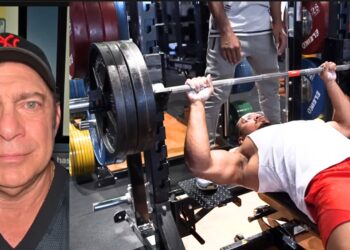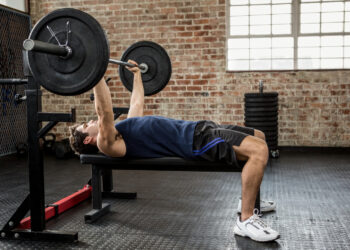As a former powerlifter, I’ve done plenty of bench pressing. But, to be honest, it was always my weakest competitive lift. Long arms and a slender ectomorphic frame mean I’m not built to be a great bench presser.
However, I’m also a veteran personal trainer who loves to confront fitness challenges head-on. Consequently, I’ve spent a lot of time learning how to maximize my bench press performance and make the most of my bad genes.
Over the years, I’ve experimented with everything from different accessory exercises to increased training frequency to crack the bench press cheat code. Long story short, at 45, I benched 135kg/300lbs at a body weight of 80kg/175lbs. While this is hardly record-breaking, I’m proud of this achievement as it far exceeded my previous personal best.
One of the best bench press boosters I discovered is also one of the most unusual – the offset load bench press. In this article, I reveal how to do this unique exercise and why it deserves a place in your bench press workouts.
Offset Load Bench Press Correct Form
Avoid injury and get the most from offset load bench presses by following these step-by-step instructions.
- Load your barbell with an uneven weight. Aim for a 5-10% weight difference if this is your first time doing offset load bench presses.
- Lie on your bench with your eyes directly beneath the bar.
- Plant your feet firmly on the floor, and hold the bar with an overhand, slightly wider-than-shoulder-width grip.
- Push your upper back into the bench and pinch your shoulder blades together. Your lower back should be slightly arched.
- Unrack the barbell and hold it above your chest. Ensure the bar is level.
- Bend your arms and lower the bar to lightly touch your chest.
- Drive the weight back up, ensuring the bar remains flat.
- Perform the required number of reps.
- Rerack the bar, rest briefly, and do your next set. Remember to switch the weight offset from set to set.
Muscles Worked
Offset load bench presses are a compound upper body exercise that involves multiple joints and muscles. The main muscles trained by this exercise are:
Level Up Your Fitness: Join our 💪 strong community in Fitness Volt Newsletter. Get daily inspiration, expert-backed workouts, nutrition tips, the latest in strength sports, and the support you need to reach your goals. Subscribe for free!
- Pectoralis major
- Deltoids
- Triceps
- Rotator cuff
- Core
Pro-Trainer Tips
Get more from offset load bench presses with these tried-and-tested pro-trainer tips!
- 4-8 reps per set work best – higher and lower reps are less effective.
- Lower the bar slowly and smoothly – a 2 to 3-second eccentric works well.
- Use a good spotter to help you unrack and rerack the bar. They can also help you if you are unable to complete a rep unaided.
- Always use safety collars during this exercise, as the bar may tip and the weights can slide off.
- Increase the weight imbalance gradually – even if it’s just a couple of pounds per workout.
- Add a mid-rep pause to make this exercise even more effective.
Offset Load Bench Press Mistakes to Avoid
Make offset load bench presses as safe as possible by avoiding these common mistakes.
Going Too Heavy, Too Soon
A big bench press is a badge of honor, but this offset variation does not require such heavy weights. In fact, going too heavy could be counter-productive. So, check your ego and start light. You’ll be amazed at how hard even low loads feel when doing offset-load bench presses.
Bouncing the Bar
Leading on from the point above, make sure you lower the bar with control and avoid bouncing the bar off your chest. Imagine there is a pane of glass under your shirt, which you can touch but must not break. This controlled eccentric descent will make offset load bench presses safer and more effective.
Not Alternating Sides
It is critical that you move the offset load from one side of the bar to the other from one set to the next. This means you’ll need to do an even number of sets, i.e., four or six. That said, if you have a significant left-to-right strength imbalance, you could consider doing an extra set for your weakest side.
Not Bracing Your Core
The offset load will make you feel like you want to roll toward the heavy end of the barbell. Don’t do it! Instead, plant your feet and brace your core strongly. Do not allow your hips or shoulders to twist.
Offsetting Your Grip
Do not alter your bench press form to accommodate the offset load. This is cheating and defeats the object of the exercise. Instead, use your muscles to stabilize the uneven load rather than change your technique.
Use the indicator rings on the bar to ensure your hands are evenly positioned and lie on the center of the bench. Make sure your feet are evenly spaced, too. Avoid extending one leg out to act as a counterbalance. Again, this is cheating.
Doing This Exercise Too Often
While I am a big fan of the offset load bench press, I think it’s best used as an assistance exercise rather than a workout mainstay. Make sure you combine it with more conventional chest builders, i.e., regular barbell and dumbbell bench presses. It’s a good supplement to and not a replacement for standard chest exercises.
Offset Load Bench Press Benefits
Not sure if offset load bench presses deserve a place in your workouts? Consider these benefits and then decide.
Fix Your Left-To-Right Strength Imbalances
While it’s entirely normal to have one side stronger than the other, such differences should be pretty slight. In fact, research suggests that significant strength imbalances increase the risk of acute and chronic injuries (1). Offset load bench presses can identify and help fix such imbalances, enhancing performance and lowering your risk of injury.
Improve Your Bench Press 1RM
Powerlifters and other exercisers care about their bench press performance. Get two gym rats together, and invariably, one will ask the other, “Hey – how much do you bench?” Regular bench pressing will help improve your bench press one-repetition maximum. Still, you’ll get better results from a more prescriptive approach to your training.
Offset load bench presses address many common bench press faults, including pushing unevenly, not staying tight, not bracing, and not controlling the bar’s descent. Adding this exercise to your workouts will fix these issues and improve your conventional bench press performance.
Relief from Shoulder Pain
Bench press shoulder pain is a common problem. In many cases, this pain never really goes away, and lifters have to train around or through it. Needless to say, this can really take the fun out of your workouts.
Level Up Your Fitness: Join our 💪 strong community in Fitness Volt Newsletter. Get daily inspiration, expert-backed workouts, nutrition tips, the latest in strength sports, and the support you need to reach your goals. Subscribe for free!
Offset load bench presses force you to use lighter loads than usual, taking stress off your joints. In addition, they reinforce perfect technique, making your workouts more joint-friendly.
If conventional bench presses bother your shoulders, a cycle or two of offset-load bench presses could be just what the doctor ordered for less joint pain while maintaining your bench-press strength.
Variety
There is a saying in fitness: If you always do what you have always done, you’ll always get what you have always got. While this may sound like a silly tongue twister, it’s actually a good reminder to change your workout to avoid plateaus.
While there is nothing wrong with conventional bench presses, you can have too much of a good thing, and doing them too often could hurt rather than help your progress. Adding offset load bench presses to your workouts is one effective way to steer clear of ruts and keep making gains.
A Better Warm-Up
A good workout starts with a thorough warm-up. This usually means some light cardio followed by dynamic mobility and flexibility exercises for the body parts you are about to train. Enlightened lifters may also add muscle activation exercises and ramped sets to their warm-ups.
I’ve also found one set per side of offset load bench presses is a great way to fire up your muscles and nervous system before a bench press workout.
Offset load bench presses enhance your mind-muscle connection and help reinforce the correct bench press technique. They also make conventional bench presses feel easier, which provides a nice confidence boost at the start of your workout.
Offset Load Bench Press Alternatives
While I’m a huge fan of offset load bench presses, I acknowledge that it’s not the only way to achieve your fitness objectives. Here are some additional exercises that deliver similar benefits.
1. Single-Arm Dumbbell Bench Press
If you train at home, you may not have access to a barbell or bench press station. However, that doesn’t mean you must miss out on the benefits of this amazing exercise. All you need is a single dumbbell or kettlebell and exercise bench, and you’ll be good to go!
Steps:
- Lie on a bench and hold a single dumbbell above your shoulder. Brace your core and plant your feet firmly on the floor.
- Bend your arm and lower the weight to the outside of your chest. Tuck your elbow into your side as the weight descends.
- Extend your arm and repeat.
- Do the same number of reps on both sides.
- No bench? No problem! You can do single-arm dumbbell floor presses instead.
2. Offset Push-Up
The offset push-up works much the same way as offset load bench presses. However, with no equipment required, they’re the ideal choice for exercise minimalists and home workouts. This exercise is an excellent preparatory step toward one-arm push-ups.
Steps:
- Adopt the push-up position with your hands around shoulder-width apart, fingers pointing forward.
- Move one hand back toward your hip and shift your weight over onto your other hand.
- Bend your arms and lower your chest to the floor. Use the hand nearest your hip for assistance only.
- Push yourself back up and repeat.
- Switch hands set by set.
- You can make this exercise easier by bending your legs and resting on your knees.
3. Single-Arm Cable Chest Press
Cable machines are incredibly versatile, and you can use one to train virtually every muscle in your body. This unilateral chest move is a great way to fix left-to-right strength imbalances while working on your core. It’s also a very joint-friendly exercise, and it is usually well tolerated even by those with mild to moderate shoulder pain.
Steps:
- Attach a D-shaped handle to a cable machine set to about mid-chest height.
- Hold the handle in one hand.
- With your back to the weight stack, take a step forward and adopt a split stance.
- Brace your core and square your hips and shoulders.
- Extend your arm and press the handle out to arm’s length.
- Bring the handle back to your shoulder and repeat.
- Switch sides and do the same number of reps with your other arm.
- You can also do this exercise with a resistance band.
Closing Thoughts
The offset load bench press is a very humbling exercise. It forces you to use relatively light weights and even makes them feel heavy. This can be hard on your ego, especially if you are typically a big bencher.
However, in my experience, this exercise is also one of the best ways to boost your bench press performance. It helps eliminate the imbalances and weaknesses preventing you from reaching your bench press potential while being kind to your joints.
Add this exercise to your upper body workouts, and your bench progress will explode. Your next stop? A new one-repetition maximum!
References:
- Wanke EM, Schreiter J, Groneberg DA, Weisser B. Muscular imbalances and balance capability in dance. J Occup Med Toxicol. 2018 Dec 3;13:36. doi: 10.1186/s12995-018-0218-5. PMID: 30534189; PMCID: PMC6278099.
Related:
Featured image via @truefitnesswindsor713 on YouTube!
Interested in measuring your progress? Check out our strength standards for Bench Press, Dumbbell Floor Press, Push Ups, and more.








